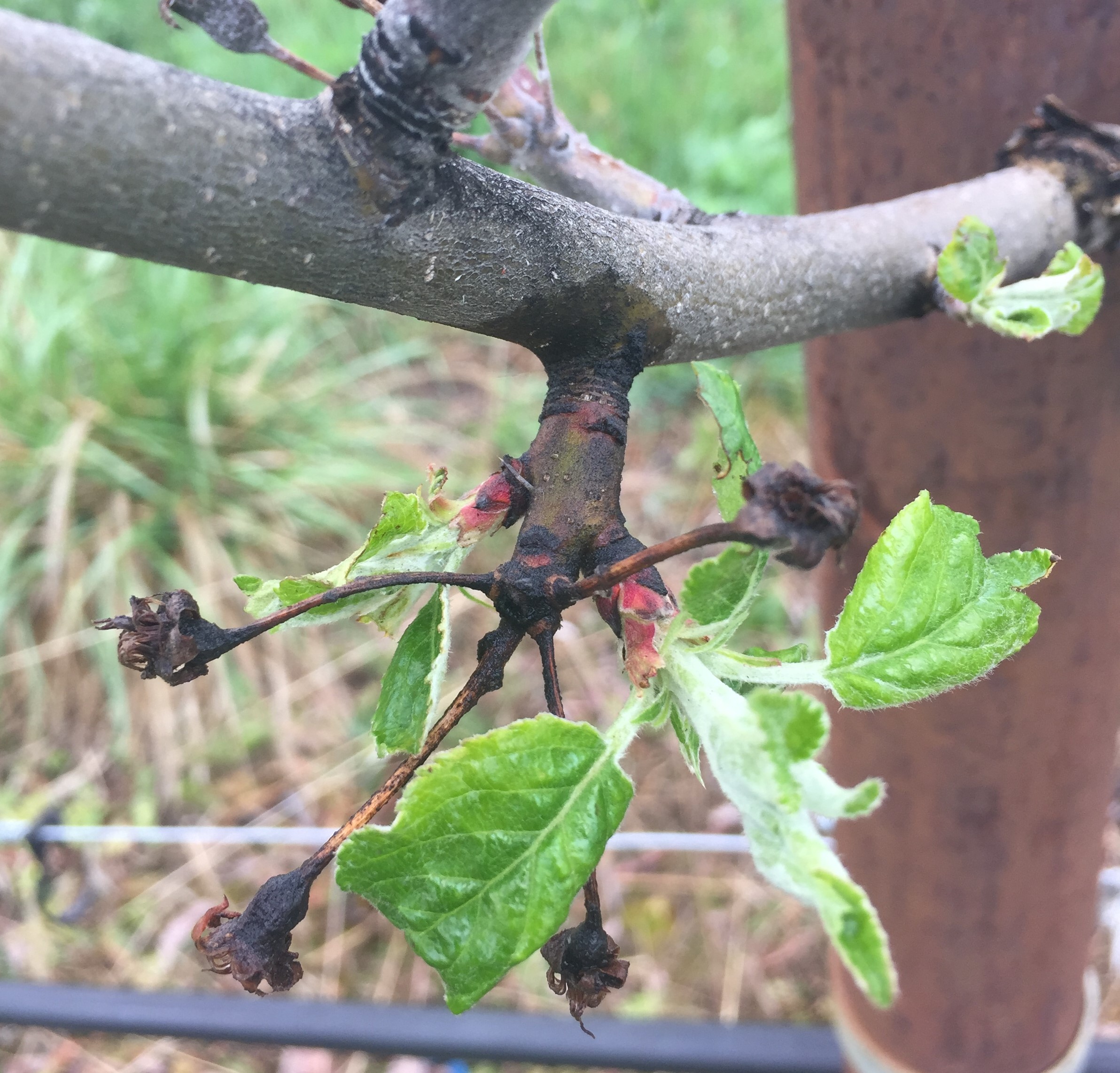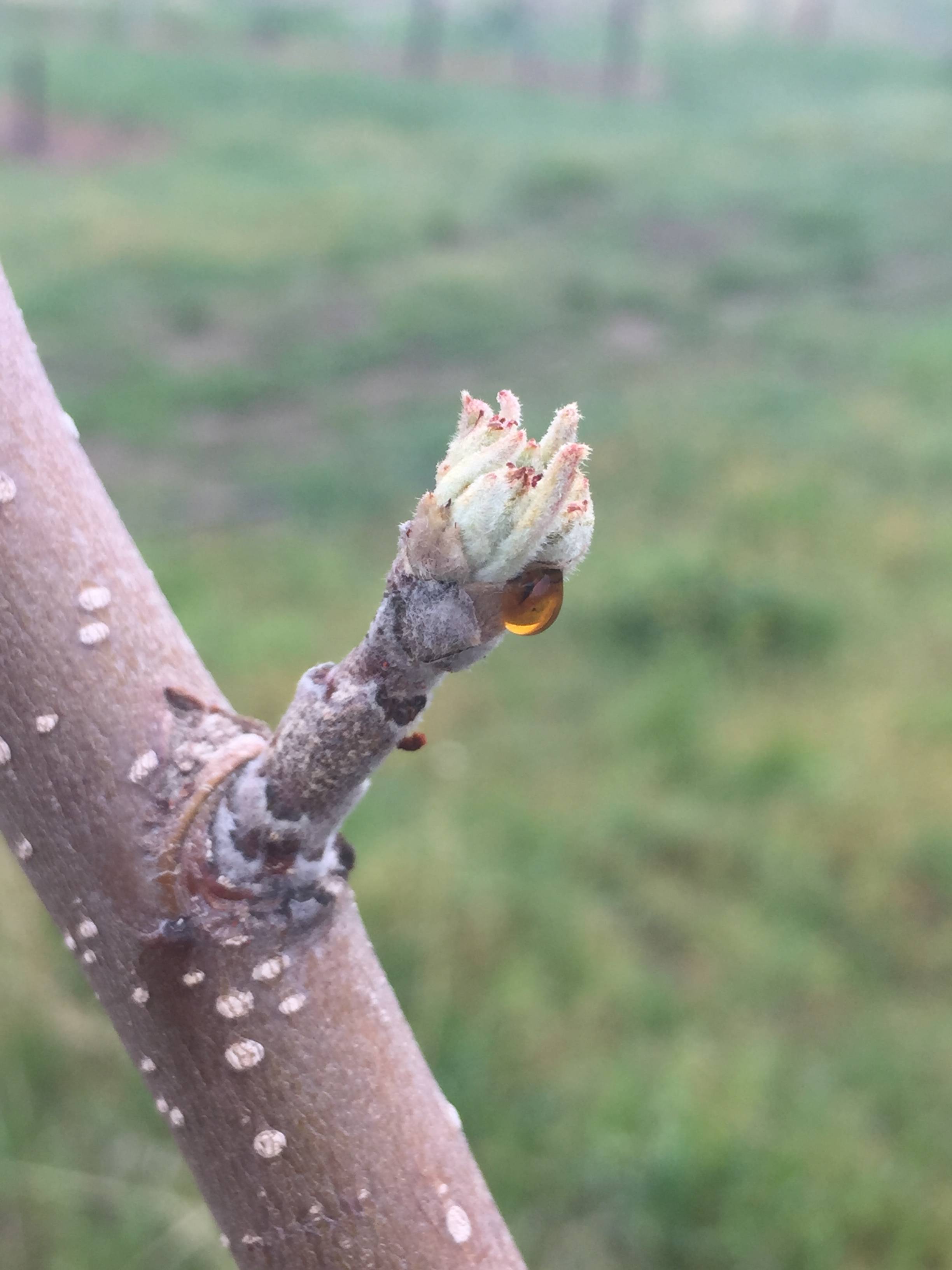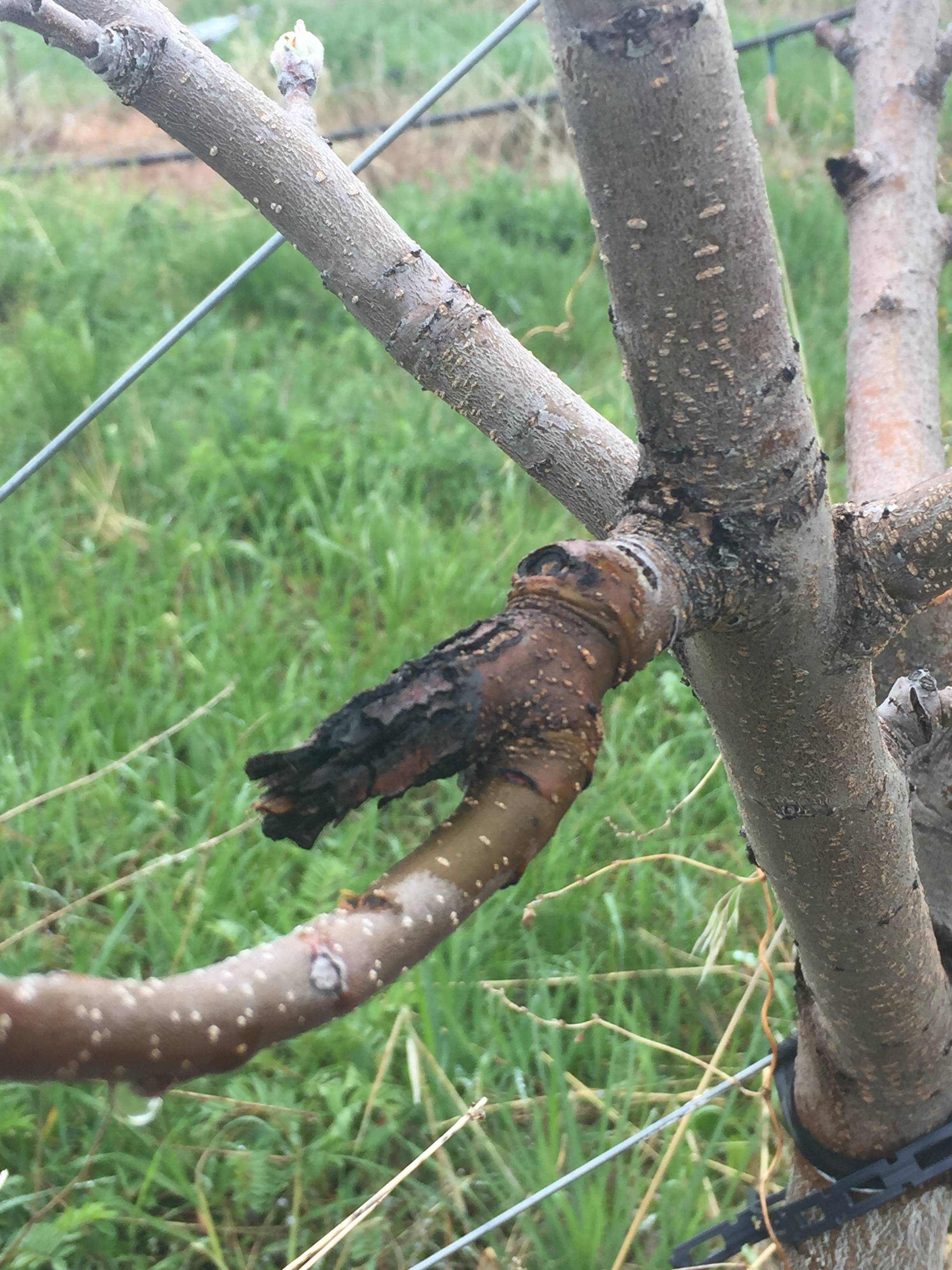Fire Blight Management in Montana Orchards
Overview
Fire blight (Erwinia amylovora) is a major bacterial pathogen of apple trees in Montana (Zidack et al.). It infects pear and apple blossoms and can rapidly spread through the tree, killing both the scion and the rootstock of susceptible cultivars. Young trees are particularly vulnerable to the disease, which thrives under warm (70-90°F) and humid conditions. In addition to infecting pears and apples, it can affect other members of the Rosaceae family, including native mountain ash, serviceberry, raspberry, cotoneaster, and hawthorn (Koetter and Grabowski). Fire blight spreads between trees primarily by insects and secondarily by wind and rain.
Identification
Once infected, blossoms may appear shriveled or frost-damaged. As the pathogen spreads, branch tips will appear scorched and droop with the characteristic “shepherd’s crook.” Later, infected fruit oozes and branches develop cankers. Insects spread the bacterial ooze, which can infect trees through wounds. Early detection is an important aspect of controlling fire blight. WSU Fire Blight guide offers comprehensive identification information in addition to management resources. Michigan State University provides a thorough guide on scouting for blossom blight symptoms of fire blight in apples for early detection. MSU's Schutter Diagnostic Lab can identify and confirm fire blight present in orchard specimins. Samples of potentially infected plant matter can be submitted to the lab through your Montana extension office. The photos above and below are of early spring infections in flower buds and cankers where infection has overwintered, providing inoculum for future infections.
Risk Factors Contributing to Fire Blight Infection
The risk of fire blight in an orchard depends on cultivar susceptibility, length of the bloom period (typically increases with the number of cultivars planted), tree age and vigor, local presence of fire blight, and risk of infection based on heat and humidity during bloom. This fire blight risk tool can help growers determine their general risk based on factors contributing to the presence and spread of fire blight in a given orchard. More information about each factor is provided below.
Cultivar susceptibility
When fire blight-resistant cultivars are exposed to the pathogen, it will not spread throughout the tree. More susceptible cultivars can be severely damaged or even killed by the pathogen as it spreads to limbs, trunk, and roots—if grafted to a susceptible rootstock.
Reducing risk
Choose cultivars and rootstocks that are resistant to fire blight. If you must plant susceptible cultivars, try to select resistant rootstocks and take fire blight-preventative measures when trees are young. For example, Montana cider apple growers have found that several of the cultivars grown for hard cider production are very susceptible to the disease including Harry Masters Jersey, Brown Snout, Sommerset Redstreak, Muscadette de Dieppe, Chisel Jersey, Dabinette and Porter's Perfection. By removing flowers when the trees are young, they can reach an age when they are less susceptible to being permanently damaged by the pathogen.
Additional Resources
Disease susceptibility of common apple cultivars
Fire blight resistant apple varieties (includes some cider apple cultivars)
Resistant rootstocks key to surviving fireblight, Good Fruit Grower
Length of the bloom period and late blooming cultivars
As bloom period increases, so does fire blight risk. The pathogen spreads more readily at warmer temperatures. Orchards with a mix of cultivars are more at risk for the spread of fire blight, as they often have a lengthier bloom period. Similarly, later-blooming varieties are at higher risk as a result of favorable fire blight conditions later in the spring.
Reducing risk
Minimize numbers of Rosaceae cultivars and select early-blooming cultivars. Secondary (“rat-tail”) blossoms can also be removed with lime sulfur sprays or hand thinning to reduce infection opportunities when risk is high.
Additional Resources
Cultivars are often classified as having early, mid or late bloom times. WSU has collected several years of data tracking full bloom in several cider apple cultivars. This information is available in their annual reports located in the WSU Cider Gallery.
Tree age and vigor
One of the primary factors for the extent of infection in trees is their age and vigor. Fire blight will spread more easily to vital areas of the tree, including the trunk and roots, if trees are young and vigorous.
Ways to reduce risk
During the establishment phase and early production, an aggressive approach to fire blight prevention and management is necessary, especially if an intense nutrition program is being used to encourage rapid growth. Protect young trees with a weekly copper spray program from spring through summer in their first through third year. Blossoms from very young trees can be hand thinned. If fire blight is contracted, trees should be pruned quickly and aggressively to remove infections.
Additional resources
"Taking the fight to fire blight" includes several tips on protecting young trees.
"Dealing with fire blight once it is in the orchard" provides helpful tips on how to scout for fire blight, prune diseased trees, and dispose of infected material.
Fire blight in the neighborhood
If trees had fire blight last year, chances are that fire blight will be a problem the following year. This not only goes for a particular orchard but for the general neighborhood, or the distance a pollinator will forage. Growers should be aware that the pathogen may be present even in orchards with few if any symptoms. For example, an old Macintosh may show few signs of fire blight damage, however, inoculum on the tree may still be present and can be carried to more susceptible trees in the area by pollinators.
Ways to reduce risk
Be proactive if fire blight is active locally. Fixed copper sprays can provide some sanitation but are only necessary if fire blight was in the area the previous season. Use the Cougar Blight Model to determine high risk times and apply treatments accordingly. The model provides different recommendations based on the activity of fire blight in the current and previous year.
Orchard Management Approach
Spray options from most to least effective are streptomycin > Kasumin® > Previsto® (OMRI listed) > oxytetracyline > Cueva® (OMRI listed) > Serenade® Opti (OMRI listed). Options like Blossom Protect™ can be effective in both conventional and organic spray programs when applied at 70% bloom to the whole row. Antibiotics—particularly streptomycin—should be used with caution to avoid the development of bacterial resistance.
Ways to reduce risk
Use an integrated approach to pest management by planting fire blight-resistant varieties, practicing good orchard sanitation, keeping humidity low during bloom, and timing spray applications strategically.
Additional Resources
For additional information on using Blossom Protect™ effectively, visit Fire Blight Management-Tips for Using Blossom Protect. For more information on organic control of fire blight, download the Organic Center's report "Grower Lessons and Emerging Research for Developing an Integrated Non-Antibiotic Fire Blight Control Program in Organic Fruit."
Heat and humidity during bloom
The optimal conditions for fire blight growth are temperatures between 75-90°F coinciding with a rain or dew event. Flowers can be infected only when open.
Ways to reduce risk
Watch the Cougar Blight Model for information on high risk events. Avoid sprinkler irrigation. Even drip irrigation can be paused during bloom and petal fall with little consequence to fruit production.
Management Options
An integrated fire blight management approach includes:
- Selecting fire blight resistant cultivars (both scion and rootstock)
- Caring for trees properly by using optimal methods and timing for irrigation (minimize watering during bloom to reduce orchard humidity) pruning, fertilization (limit vigor by avoiding high fertility applications), and pest management
- Removing blossoms in very young trees
- Scouting often to identify infections as soon as possible
- Removing infected plant material quickly
- Using a preventative spray program based on tree phenology—rather than relying solely on weather conditions—to determine high-risk periods
Backyard growers can often avoid spraying by implementing the cultural controls listed in 1-5, above. Avoid antibiotic products—particularly streptomycin— to reduce the chance of fire blight bacteria developing resistence. Read more about fire blight management options for backyard growers.
Chemical options
Sprays vary in their mode of action. For example, copper sprays provide dormant season sanitation, biological sprays contain yeasts that compete with the bacteria, and antibiotics directly kill the pathogen. The WSU Fire Blight guide describes these control options and provides a suite of organic and conventional management options. Developing a plan for fire blight control based on your orchard's risk and tree susceptibility is also an important step toward being prepared to act quickly when conditions arise. WSU's Plan for Multiple Fire Blight Conditions, Be Agile is a helpful resource for conventional and organic growers with various levels of risk.
The use of the products listed in the WSU guide are applicable to Montana growers, with the possible exception of early lime sulfur and oil treatments to thin blossoms. This is not always necessary in Montana, where frost can provide this service. However, later and lingering "rat-tail" blossoms may be thinned with lime sulfur to reduce the risk of infection in cultivars with such tendencies. As with any chemical, growers should confirm the product is labeled for use in Montana and follow the instructions carefully.
Regardless of tree age or disease management approach, spray timing is crucial to the success of antibiotic and biological sprays to control fire blight. According to the Crop Protection Guide for Fruit Trees in Washington, sprays should be applied within a 24-hour period prior to a wetting event during a high-risk period. The Cougar Blight Model helps growers with appropriate spray timing based on forecasted heat and humidity and infection risk based on the presence of fire blight in the area. This chemical cost calculator for products labeled in Montana can help growers weigh their risks and fire blight management options against the cost of various spray options.
As with any pest or disease management program, it is important to take an integrated approach. While planting resistant rootstocks and cultivars is a good foundation, identifying infection early and aggressively pruning out infected plant material is an important factor in reducing risk during infection periods and can reduce the need for using sprays. In addition, Growing Produce’s article titled "Integrating Control Methods to Tackle Fire Blight" provides several helpful tips on how to maximize the benefits of available management options to control fire blight.
For more information on managing fire blight in Montana, watch "Fire blight in Montana", presented by Dr. Ken Johnson as part of a workshop on IPM in Montana Orchards.
Disclaimer: These recommendations are provided only as a guide. It is always the pesticide applicator’s responsibility, by law, to read and follow all current label directions for the specific pesticide being used. Due to constantly changing labels and product registration, some of the recommendations given in this writing may no longer be legal by the time you read them. If any information in these recommendations disagrees with the label, the recommendation must be disregarded. No endorsement is intended for products mentioned. The authors and Montana State University assume no liability resulting from the use of these recommendations.




